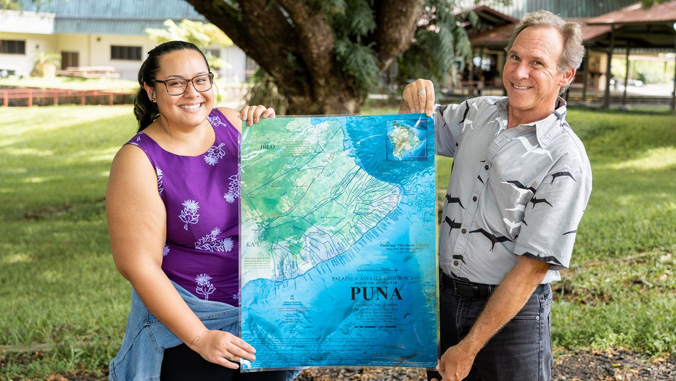
University of Hawaiʻi at Hilo senior geography student Kaylyn Ells-Hoʻokano, with mentor and Hawaiʻi Community College geography instructor Drew Kapp, co-created a map that details the ahupuaʻa (traditional land divisions) of Hawaiʻi Island’s moku (district) of Puna. Their map is a free resource for the public, especially valuable to community members, students and educators.
The map was presented last month at the annual meeting of the Association of Pacific Coast Geographers in Arizona, where it garnered a lot of views and questions. Kapp noted that mapmaking is both artistic and highly technical, but Ells-Hoʻokano quickly developed the required expertise.
“The cartographic piece is the art of the map, and that has to do with perspective, the language, fonts and colors that you choose and where you place the text and background imagery,” said Kapp. “We made an east arrow instead of a north arrow because the sun first rises at Kumukahi in Puna, and this shape of the east arrow reflects the rising sun, too. The map is in Hawaiian and English, and that makes it special.”

The motivation behind the map
Ells-Hoʻokano was asked by Kapp to be an intern on the project because of her geography major and Hawaiian studies minor. Additionally, both Ells-Hoʻokano and Kapp have a rooted connection with the Puna district and view the map as an opportunity to give back to the community and foster pride in their moku.
“She had the passion to not only deepen her knowledge of the district of Puna, which we both love, but also to outreach to the community about the importance of knowing your ahupuaʻa and traditional names,” said Kapp.
The mapping project helps clarify misconceptions and inaccuracies of Puna, whether it be about the folklore and traditions, the current residents or the landscape that was greatly affected by volcanic activity.
“We want residents to know which of these traditional land divisions they can affiliate themselves with and honor those original names and ways of understanding the landscape,” said Kapp. “During the Kīlauea eruption people responded to it in different ways, but we also recognize that if you are familiar with what the traditional place names tell you, then you would know to expect that kind of activity. The place names tell us what to expect and how to interact with those places and how to conduct ourselves. That’s why for us the place names are really significant.”
The next phase of the project is to build a web-based interactive map featuring oli (chants), ʻōlelo noʻeau (poetical sayings) and information known about a particular ahupuaʻa.
For the full story, visit the UH Hilo Stories website.
—By Leah Sherwood, a graduate student in the tropical conservation biology and environmental science program at UH Hilo.

